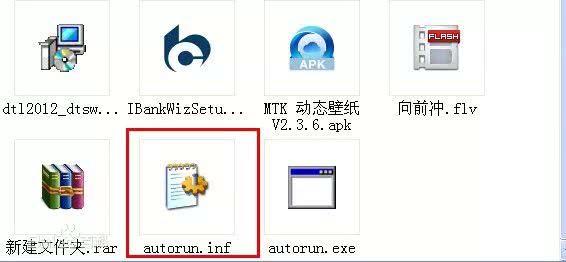
php editor Baicao introduces you to a very practical tool - U disk self-starting immunity. In the daily use of computers, we often encounter threats from various viruses and malware, especially viruses spread through USB flash drives. The U disk self-starting immunity is a tool that can protect the security of the U disk and the computer. It can help us automatically detect and disinfect malicious files in the U disk to prevent the computer from being infected by viruses. Using U disk self-starting immunity, we can use U disk with more confidence and improve the security of the computer.

Many friends will have doubts. They copied a file on someone else's computer. Where did the virus come from? In fact, many of the viruses spread by using USB flash drives in the local area network are related to a file called "autorun.ini".
 What the hell is autorun.inf?
What the hell is autorun.inf? Actually, autorun.inf is one of the more common files in our computers. Its main function is to allow a specified file to be automatically run when a disk is double-clicked. However, a new threat has emerged in recent years, which is the spread of Trojans or viruses through the autorun.inf file. These malicious programs take advantage of the user's misoperation to cause the target program to execute, thereby achieving the purpose of invading the computer. This phenomenon has had a great negative impact on computer security. Therefore, in order to protect the security of our personal computers, we should always be vigilant and avoid opening disks or files from unknown sources at will. In addition, it is also very important to update anti-virus software and operating system patches in a timely manner so that any potential threats can be discovered and eliminated in a timely manner.
When this file appears on the U disk, once the U disk is inserted into the computer, the system will automatically read its contents and execute the specified program. This is the principle of the U disk automatically spreading viruses. Therefore, although the USB flash drive itself is a good thing, if it is used illegally, it will have adverse effects.
 How to prevent the virus from the USB flash drive from spreading to your computer?
How to prevent the virus from the USB flash drive from spreading to your computer? After understanding the operating principle of viruses on USB flash drives, we can take some effective measures to prevent infection. First, when inserting the USB flash drive, you can hold down the [Shift] key on the keyboard until the computer fully recognizes and displays the USB flash drive. The purpose of this is to prevent the U disk from running automatically, thereby avoiding the automatic spread of viruses. In addition, we can also regularly use anti-virus software to comprehensively scan the USB flash drive to detect and eliminate potential virus threats in a timely manner. Also, avoid inserting USB drives into untrusted devices to reduce the risk of infection. Keeping the operating system and security software updated is also an important protective measure, because they can provide the latest security patches and virus definition databases to help us resist
How to delete autorun.inf fileWhen we find ourselves in a USB flash drive When there is a virus, the file autorun.inf usually appears. We can solve the problem by deleting this file and using anti-virus software to fully scan and clean the USB flash drive. However, sometimes the autorun.inf file may be hidden and cannot be seen directly. In this case, you can follow these steps: 1. First, open "File Explorer" (Windows operating system) or "Finder" (Mac operating system). 2. Find the "View" option on the toolbar and click it. 3. In the "View" option, check the "Hidden items" or "Show hidden files" option. 4. After confirmation, you will be able to see the hidden autorun.inf file. 5. Select the autorun.inf file, right-click and select "Delete" to delete it. 6. Next, use reliable anti-virus software to fully scan and clean the USB flash drive, make sure
Open the computer, click Tools, and then select Folder Options. Find [Hide protected operating system files (recommended)] in the View tab of Folder Options and uncheck it. At the same time, check the [Show hidden files, folders, and drives] option below and click Apply. In this way you can see the autorun.inf file in the root directory of the USB flash drive.
Every time after deleting it, I find that the file reappears when I use the infected USB flash drive again, which is really troublesome. The best way is to immunize the USB flash drive.
 How to immunize a USB flash drive?
How to immunize a USB flash drive? 1. Open the U disk and create a new folder in the root directory, and then change the name to autorun.inf
2. Press the [Win R] shortcut key to open the run window and enter [CMD] and Press Enter to open the command line window
3. Enter the following command and press Enter
md X:\autorun.inf\U disk immunity...\
Must not Forgot to enter the last 3 dots and the backslash. In addition, the X above represents the drive letter of your USB flash drive. If your U disk is F disk, enter [f:\autorun.inf\U disk immunity...\], if it is G disk, enter [g:\autorun.inf\U disk immunity...\]
After entering, you will find that there is an additional folder named [U disk immunity...] in the autorun.inf of the U disk. However, this folder cannot be deleted.

If there is a virus and wants to create a new autorun.inf file, it will not be created, which plays a role in immunizing the U disk.
Have you learned this skill? Everyone is welcome to leave comments and exchanges.
The above is the detailed content of U disk self-starting immunity. For more information, please follow other related articles on the PHP Chinese website!




